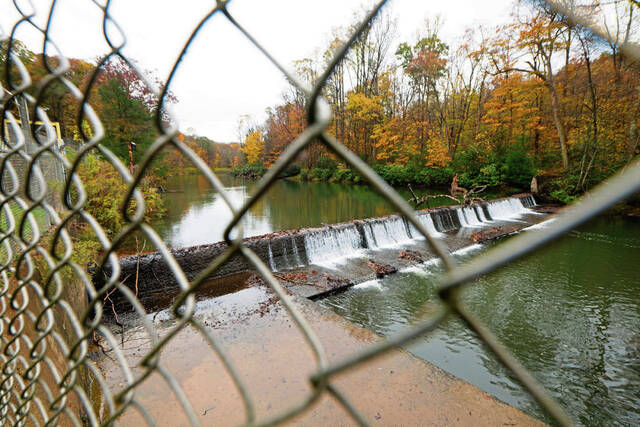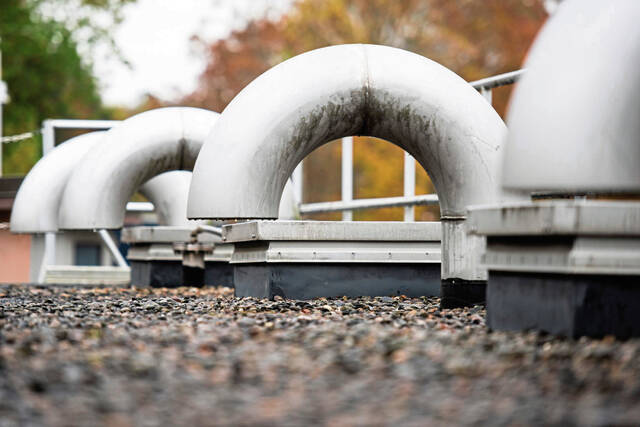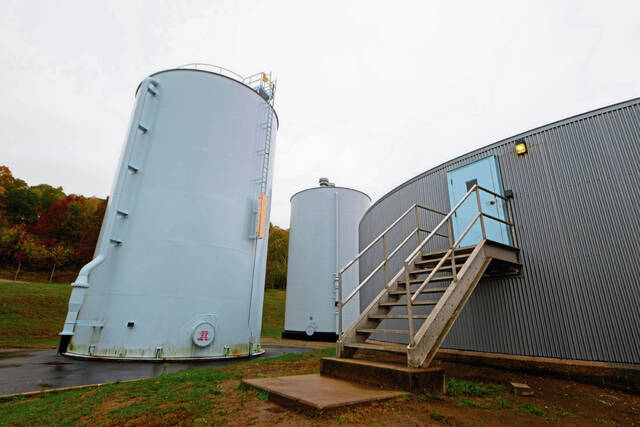Surge in computer data centers sparks concern over water demands
A proposed 4.4-gigawatt natural gas-fired power plant south of Homer City, intended to power a nearby data processing center, is drawing scrutiny over its possible massive water demands on a local stream.
The Homer City Redevelopment Co. plant would siphon water from Two Lick Creek to feed the data centers and their cooling systems. Just how much water the two intake pipes will draw from the creek, about 10 miles downstream of Two Lick Reservoir, has yet to be disclosed to state officials. The reservoir holds 5 billion gallons.
Local residents and environmental groups are concerned this proposed usage — and a proliferation of similar data center plans statewide — could strain Pennsylvania’s water resources.
Blacklick Creek Watershed Association President Janis Long said her group has been asking the state Department of Environmental Protection about water usage and “not getting an answer.”
Blacklick Creek, which is fed by Yellow and Two Lick creeks, flows into the Conemaugh River north of Blairsville.
Data center water demand
The concern over the water and energy demands of artificial intelligence (AI) data centers is shared by communities and water companies across Pennsylvania, said Brigitte Meyer, a staff attorney for PennFuture, a statewide environmental organization.
Pennsylvania has become a hotspot for this development, with at least 23 proposed data centers across the state, including sites in Allegheny, Indiana and Westmoreland counties. The state does not formally track the proposals, but a Pennsylvania Data Center Proposal Map showed 21 hyperscale data centers in planning stages as of late October. Northern Virginia is considered ground zero for the growth of data center sites, where the Northern Virginia Regional Commission reports there are more than 250 facilities.
“We have surprisingly little regulation on water usage. We’ve always been considered a water-rich state,” Meyer said, referencing major state rivers such as the Delaware, Susquehanna, Monongahela, Allegheny and Ohio, along with Lake Erie.
Water utilities, which are used to managing supply for their existing customer base, could face major challenges meeting the sudden increased demand from data centers and the power plants that cool them, said Adam Carpenter, manager of energy and environmental policy at the American Water Works Association.
Carpenter noted utilities must also ensure they are “not subsidizing the cost (for water) of the data processing from your residential (customers).”
Homer City project details
Homer City Redevelopment has a permit to draw water from Two Lick Creek and a National Pollutant Discharge Elimination System permit to dump treated water back into the stream, said Tom Decker, a DEP spokesman. The amount of water it can remove is not capped, though the Two Lick Reservoir operator must discharge at least 7.1 million gallons per day into the creek.
“Different data center types will have different water needs, so I’m not in a position to answer your question at this point in the process,” said a Homer City Redevelopment spokesman, who declined to be identified.
The data centers’ demand for water varies, depending upon several factors, including whether the electricity is used to cool the computer systems or water that flows through a coolant system, Carpenter said.
When the site’s previous operator ran the coal-fired Homer City Generation plant in 2020, it pulled 5.6 million gallons of water per day from Two Lick Creek, according to DEP data.
Pennsylvania American Water, which draws about 2.2 million gallons of water a day from Two Lick Creek several miles upstream for its Indiana-area customers, has been proactively communicating with Homer City Redevelopment.
“It is really, really important,” said Justin Ladner, president of the water company, which serves 2.4 million customers statewide.
“We want to support economic development in a responsible way,” Ladner said. “We understand the development needs … but want to be fair to everyone.”
Concerns in Springdale, Upper Burrell
In Springdale, the former Cheswick Generation Plant is the projected site of a 565,000-square-foot hyperscale data center and a 200,000-square-foot cooling plant. Developers are proposing a closed-loop system to cool the processors, which would only require an initial 500,000 gallons to “charge” the system, followed by much smaller amounts to replace evaporated water.
“We don’t think it will be a problem for the residents,” said Springdale Borough Manager Terry Carcella.
Meanwhile, TECfusions Inc. plans to convert the 1,395-acre former Alcoa Technical Center in Upper Burrell into a site for a 3-gigawatt natural gas plant to power a data center campus. The site already has 12 megawatts of power available for immediate use, the company said.
The site gets its water from the Municipal Authority of the City of New Kensington, but the authority’s distribution Harold Smith Burns Treatment Plant Superintendent, Ed Saliba Jr., said no one from TECfusions has contacted him about the project’s water needs.
TECfusions spokeswoman Melissa Farney said the company has not yet determined water needs because it does not know how prospective data centers will cool their processors.
Some cooling systems use a closed system that circulates the water, and others use treated wastewater, although that could lead to bacteria build-up, Farney said. Some cooling systems are powered by electricity.
Proposed legislative responses
The intense power demands of data centers are driving a legislative response.
State Rep. Robert Matzie, D-Beaver, introduced House Bill 1834, which would give the Pennsylvania Public Utility Commission (PUC) regulatory oversight over commercial data centers. The bill would also:
• Bar public utilities that operate data centers from recovering associated costs.
• Require those utilities to generate at least 25% of their power from renewable sources.
• Mandate a $500,000 annual payment to the state’s Low-Income Home Energy Assistance Program (LIHEAP) for power plants generation 100 megawatts or more
Matzie could not be reached for comment.
The focus on proposed regulation initiatives has been on the energy side and its impact on the power grid, PennFuture’s Meyer said.
“Looking at water needs would be wise,” Meyer said. PennFuture has developed a proposed zoning ordinance that would require a water feasibility study for data centers.
Conversely, a Republican-backed bill in the Senate, proposed by state Sens. Patrick Stefano, R-Fayette and Westmoreland, and Carmen Bartolotta, R-Washington, would fast-track permitting by eliminating the need for developers to submit permit applications to the DEP before site preparations begins on any demolition or earthmoving, but not to build a data center or power generation plant.
A professional engineer would have submit documents on the plant location, energy source and transmission infrastructure. This would circumvent public reviews and eliminate the need for permits associated with water use, erosion and sediment control, wastewater or floodway encroachments. The DEP would get three days to review the application.
The DEP would have to identify 15 sites the governor and other relevant state agencies deem appropriate for data centers, five of which could have a power plant.
Neither Stefano nor Bartolotta could be reached for comment Friday.
Joe Napsha is a TribLive reporter covering Irwin, North Huntingdon and the Norwin School District. He also writes about business issues. He grew up on Neville Island and has worked at the Trib since the early 1980s. He can be reached at jnapsha@triblive.com.
Remove the ads from your TribLIVE reading experience but still support the journalists who create the content with TribLIVE Ad-Free.




